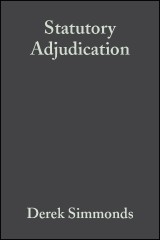Details

Statutory Adjudication
A Practical Guide1. Aufl.
|
91,99 € |
|
| Verlag: | Wiley-Blackwell |
| Format: | |
| Veröffentl.: | 15.04.2008 |
| ISBN/EAN: | 9781405150996 |
| Sprache: | englisch |
| Anzahl Seiten: | 288 |
DRM-geschütztes eBook, Sie benötigen z.B. Adobe Digital Editions und eine Adobe ID zum Lesen.
Beschreibungen
Existing books on construction adjudication have either been written as an introduction to the subject when the Housing Grants, Construction and Regeneration Act was first introduced in 1996, or they are aimed at professionals representing parties or at adjudicators themselves. <p>In contrast, this book has been written for the parties to adjudication, particularly those new to the process. It takes a straightforward, practical approach to the subject, dealing with the process step-by-step.</p> <p>The first part takes a party who is referring a dispute through the stages of the adjudication process, including the presentation of a referral submission, to the enforcement of an award.</p> <p>Part 2 examines the position of a party faced with adjudication, highlighting the various actions necessary to protect its interest, and explains how a decision can be challenged. Part 3 looks at matters of common interest.</p> <p>Statutory payment provisions and the Scheme for Construction Contracts are dealt with in Part 4, and Part 5 compares the most frequently used adjudication provisions and procedures. Appendices include an alphabetical list of 139 adjudication cases which are also categorised to show the aspect or aspects with which they are principally concerned.</p>
Preface. <p>Abbreviations.</p> <p><b>PART 1: An Introduction to Adjudication.</b></p> <p>1. Adjudication - a brief resume.</p> <p>2. The need to change in the construction industry.</p> <p>3. Some adjudication terminology.</p> <p><b>PART 2: So You Want To Go To Adjudication?</b>.</p> <p>1. Is referral to adjudication really in your best interests?.</p> <p>2. Your entitlement to refer dispute to adjudication under the Housing Grants, Construction and Regeneration Act 1996.</p> <p>2.5. Does the Act apply to your contract?.</p> <p>2.6 Other considerations.</p> <p>2.7 Summary.</p> <p>3. What next?.</p> <p>4. What will it cost?.</p> <p>5. Getting the adjudication under way.</p> <p>6. The conduct of the adjudication.</p> <p>7. the decision.</p> <p>8. Enforcement of the decision.</p> <p><b>PART 3: So You Are Being Taken To Adjudication.</b></p> <p>1. Initial Steps.</p> <p>2. Objecting to becoming involved.</p> <p>3. Active participation.</p> <p>4. When the decision is ready.</p> <p>5. Challenging the decision or its enforcement.</p> <p><b>PART 4: Matters of Common Interest.</b></p> <p>1. During the currency of the adjudication.</p> <p>2. After the adjudicator has released his decision.</p> <p>3. Challenging the decision.</p> <p>4. The final solution.</p> <p>PART 5: Statutory Payment requirements.</p> <p>1. Resume of the requirements of the HGCRA and related regulations of the Scheme for Construction Contracts.</p> <p><b>PART 6: Comparison of the Scheme for Construction Contracts and other principles adjudication provision sand procedures.</b></p> <p>1. The Scheme for Construction Contracts.</p> <p>2. The ICE Conditions of Contract, 7th Edition and Adjudication Procedure (1997).</p> <p>3. The JCT Standard Form of Building Contract 1998, Amendment 4, 2002.</p> <p>4. The Engineering and Construction Contract, Second Edition and Option Y (UK) 2 1998.</p> <p>5. Institution of Chemical Engineers Form of Contract, Third Edition 2002 and Adjudication Rules, Second Edition 201.</p> <p>6. GC/Works/1 (1998) - General Conditions.</p> <p>7. The technology and Construction Solicitors Association 2002 Version 2.0 Pr9cedural Rules for Adjudication.</p> <p>8. The Construction Industry Council Model Adjudication Procedure, Second Edition.</p> <p>9. Subcontract Forms.</p> <p><b>Appendices</b>.</p> <p>1. The Housing Grants, Construction and Regeneration Act 1996.</p> <p>2. The Construction Contracts (England and Wales)Exclusion Order 1998.</p> <p>3. The Scheme for Construction Contracts (England and Wales) Regulations 1998.</p> <p>4. Contract Adjudication Provision sand Related Procedures.</p> <p>5. Independent Adjudication Rules and Provisions.</p> <p>6. Adjudicator Nominating Bodies.</p> <p>7. Alphabetical List of Cases.</p> <p>8. Categorised List of Cases.</p> <p>Index.</p>
'No one in the business of adjudication should be without it'<br /> <p>Arbitration, February 2004</p>
<p><strong>Derek Simmonds</strong> is the author of <em>Statutory Adjudication: A Practical Guide</em>, published by Wiley.
Existing books on construction adjudication have either been written as an introduction to the subject when the Housing Grants, Construction and Regeneration Act was first introduced in 1996, or they are aimed at professionals representing parties or at adjudicators themselves.<br /> <p>In contrast, this book has been written for the parties to adjudication, particularly those new to the process. It takes a straightforward, practical approach to the subject, dealing with the process step-by-step.<br /> </p> <p>The first part takes a party who is referring a dispute through the states of the adjudication process, including the presentation of a referral submission, to the enforcement of an award.<br /> </p> <p>Part 2 examines the position of a party faced with adjudication, highlighting the various actions necessary to protect its interest, and explains how a decision can be challenged. Part 3 looks at matters of common interest.<br /> </p> <p>Statutory payment provisions and the Scheme for Construction Contracts are dealt with in Part 4, and Part 5 compares the most frequently used adjudication provisions and procedures. Appendices include an alphabetical list of 139 adjudication cases which are also categorised to show the aspect or aspects with which they are principally concerned.</p>
‘This is an excellent book that gives a true account of what English speech is really like.’ <i>Gerry Knowles, University of Lancaster</i> <!--end--><br /> <p><br /> </p> <p>‘Linda Shockey addresses questions of interest to nearly every phonetician and phonologist, providing extensive examples of attested conversational reductions in numerous dialects of English. By presenting the reductions along with their linguistic conditioning factors, she strikes a forceful blow against the belief that casual speech is simply sloppy speech. <i>Sound Patterns of Spoken English</i> will be of interest to theoretical phonologists and experimental phoneticians, as well as researchers in speech perception, language acquisition and speech technology.’ <i>Lisa Lavoie, Massachusetts Institute of Technology</i><br /> </p> <p>“…the detailed information that is densely packed into this quite short text will be appreciated by many phoneticians, who will find it an exceptionally useful summary of the processes that affect conversational speech and the contexts under which they are most likely to occur.” <i>Journal of the International Phonetic Association</i></p>

















